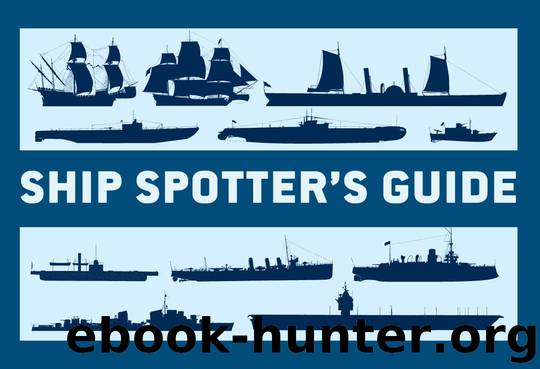Ship Spotter's Guide (General Military) by Angus Konstam

Author:Angus Konstam [Konstam, Angus]
Language: eng
Format: azw3, epub, mobi
Tags: Ship Spotter’, s Guide
ISBN: 9781472808714
Publisher: Osprey Publishing
Published: 2014-11-18T05:00:00+00:00
KRIEGSMARINE U-BOATS
The Treaty of Versailles expressly forbade Germany from rebuilding her U-boat fleet. However, by the 1920s German designers had begun to develop a new generation of U-boats, under the guise of building submersibles for export. These restrictions were lifted when the Nazis revoked the treaty in 1934. The following year Karl Dönitz became the commander of Germany’s nascent U-boat fleet, and was largely left to devise a boatbuilding programme, training, strategy and tactics for his force. He envisaged the U-boat as primarily a torpedo boat which operated on the surface, and attacked at night, but could submerge when required to evade detection. This meant he favoured vessels that behaved well on the surface, with a long range and endurance.
In 1935–36 the first two experimental Type IA U-boats were laid down, as well as six Type IIA coastal submarines (designated U1 to U6). Subsequent versions of Type II U-boats were launched between 1935 and 1940, but by then these craft were designated as being too small for Dönitz’s purposes. Instead, in 1934 he approved plans for a Type VII U-boat, and the first of these new ocean-going boats entered service in 1935–36. These were twice as large as their predecessors, and were fitted with one stern and four bow tubes, as well as a deck gun. This first batch of ten boats was dubbed Type VIIA, and they were soon followed by a larger and more powerful variant, which was designated VIIB. By the time war was declared in September 1939, there were 57 U-boats in service, and this number climbed steadily during 1940 and 1941.
In 1940 the first Type VIIC U-boats entered service – identical to the previous class, only slightly longer, and with an improved sonar – but these Type VII boats were the workhorses of the German U-boat fleet. Together they formed the wolfpacks which almost swung the tide of the war during the Battle of the Atlantic. In all, 24 type VIIB and 568 Type VIIC boats entered service. Only a handful of them survived the war.
Download
Ship Spotter's Guide (General Military) by Angus Konstam.epub
Ship Spotter's Guide (General Military) by Angus Konstam.mobi
This site does not store any files on its server. We only index and link to content provided by other sites. Please contact the content providers to delete copyright contents if any and email us, we'll remove relevant links or contents immediately.
Periodization Training for Sports by Tudor Bompa(7905)
The MacArthur Bible Commentary by John MacArthur(4646)
The Body: A Guide for Occupants by Bill Bryson(4569)
The Sports Rules Book by Human Kinetics(4067)
What It Really Takes to Get Into Ivy League and Other Highly Selective Colleges by Hughes Chuck(3542)
Marijuana Grower's Handbook by Ed Rosenthal(3507)
The Sprouting Book by Ann Wigmore(3401)
The Martian by Andy Weir(3173)
Salt, Fat, Acid, Heat: Mastering the Elements of Good Cooking by Nosrat Samin(2993)
The Bread Bible by Rose Levy Beranbaum(2881)
Sapiens and Homo Deus by Yuval Noah Harari(2837)
Classic by Mary Berry(2829)
Harry Potter 4 - Harry Potter and The Goblet of Fire by J.K.Rowling(2795)
The Marketing Plan Handbook: Develop Big-Picture Marketing Plans for Pennies on the Dollar by Robert W. Bly(2787)
Martha Stewart's Baking Handbook by Martha Stewart(2665)
Screenplay: The Foundations of Screenwriting by Syd Field(2428)
The Plant Paradox by Dr. Steven R. Gundry M.D(2420)
50 Economics Classics by Tom Butler-Bowdon(2407)
The Cambridge Grammar Of The English Language by Rodney Huddleston Geoffrey K. Pullum(2313)
